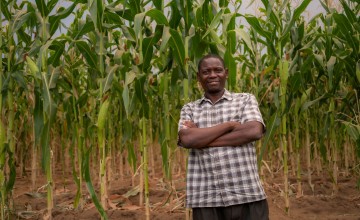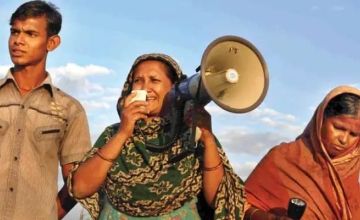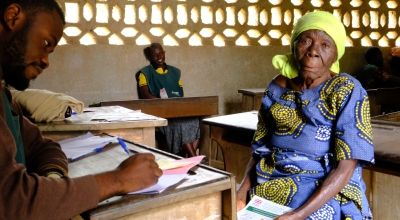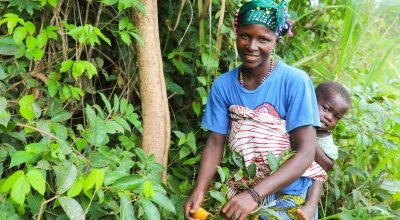
Read our 2023 annual report

Knowledge Hub
What is disaster risk reduction, and why do we need it?
In 1999, former UN Secretary-General Kofi Annan wrote, “one of the most pressing challenges of our time [is] the extraordinary increase in the number and extent of natural disasters.”
Over the 20+ years that have followed, this challenge has only become more pressing, with one UN estimate placing economic losses due to natural disasters at more than double what was lost in the previous two decades.
The cost of these disasters disproportionately hits the poorest, most vulnerable, or fragile communities hardest. The UN has also reported that people in low- and middle-income countries are seven times more likely to die from natural disasters. While initiatives like the Paris Climate Agreement have been put into place to curb greenhouse gas emissions, it’s not enough to stave off the next disaster. We can’t predict the unpredictable... but we can prepare for it.
What is disaster risk reduction?
Disaster risk reduction (DRR) protects the lives and livelihoods of communities and individuals who are most vulnerable to disasters or emergencies. Whether the crisis is caused by nature or humans (or a combination of both), DRR limits its negative impact on those who stand to lose the most.
In some cases, we can reduce the size of a disaster, its strength, or even how frequently it occurs. In tandem with this, we can also make sure that those who are most exposed to these hazards are able to better anticipate, survive, and recover. DRR focuses specifically on the three key dimensions of disaster risk:
- Exposure to hazards
- Vulnerability and capacity
- Characteristics of each hazard
The goal of DRR is to prevent new risks, reduce existing risks, and increase overall resilience.

Why is DRR important?
Head of the UN’s agency for Disaster Risk Reduction (UNDRR) Mami Mizutori sums up the problem: “ The world has been stuck in a vicious cycle of disaster → response → dependency → repeat.”
This cycle of disasters mirrors the cycle of poverty, creating dependencies instead of fostering development. But, an ounce of prevention can be worth a pound of cure. In more concrete terms, according to the UNDRR, every $1 (USD) invested in disaster risk reduction can save up to $15 in recovery. Every $1 spent to fortify infrastructures against disaster likewise saves $4 in reconstruction.
Disaster risk reduction not only saves lives, it helps to improve them — freeing up more funds for organisations like Concern to use towards long-term development versus in-the-moment emergency response.

Mitigation
What can be done to offset disasters or lessen their impact on a community? At this stage, we’re focusing on issues like local infrastructure and natural resources (more on both below).
Preparedness
How can communities prepare for events that can’t be mitigated? Solutions may include having an evacuation plan or early warning system.
Response
If an emergency can’t be mitigated and all appropriate preparations are made, this makes it easier for communities to then focus on a quick yet strategic response when emergency strikes, focusing on helping the most vulnerable people, search-and-rescue missions, and bringing in emergency supplies to make up for lost utilities like water or electricity.
Recovery
Once the immediate needs are taken care of, communities have what they need to rebuild. DRR can work in a cycle, with recovery methods leading to more effective ways of mitigating against and preparing for future disaster.

DRR at work
No two disaster risk reduction plans are the same, but there are many similar areas of focus:
Infrastructure
Often changes to a community’s infrastructure can help reduce risk for everyone living there. This includes initiatives like retaining walls, check dams, embankments, and terraces. Many of these projects are low-tech and use the resources on hand.
Natural resource management
There’s a strong link between effective DRR and improving the natural resources within a community. Reforestation and water stewardship are two ways we can offset risk. Many indigenous practices also fall under this umbrella.
Agricultural interventions
Climate Smart Agriculture and conservation agriculture are two ways we can protect a family’s crops against drought and flood.

Behavioural change
Some DRR processes are more psychological and diplomatic, such as peace-building processes and addressing the inequalities that make some people more vulnerable than others.
Evacuation procedures and safe shelters
A key part of disaster management is ensuring that there are procedures in place before an emergency occurs. Part of this is having a procedure in place for evacuating a community/region, and also having safe shelters arranged in advance.
Early warning systems
More broadly, being able to plan for an emergency before it reaches a true crisis point is also key to offsetting the risks that come with disasters. Early Warning, Early Action (EWEA) and preparedness planning improves local response when emergencies strike.

Concern’s approach to disaster risk reduction
Concern is a dual-mandate organisation, meaning that we respond to both immediate humanitarian emergencies while also focusing on longer-term development that will help communities lift themselves out of poverty.
As such, DRR is a fundamental aspect of our work and we have our own core approaches to DRR. Learn more about how Concern approaches disaster risk reduction.




